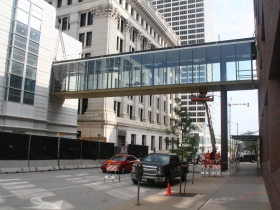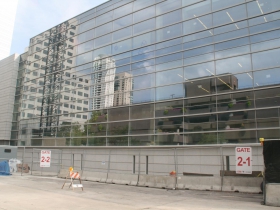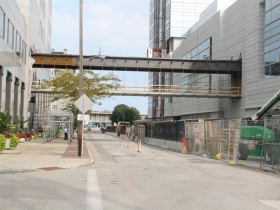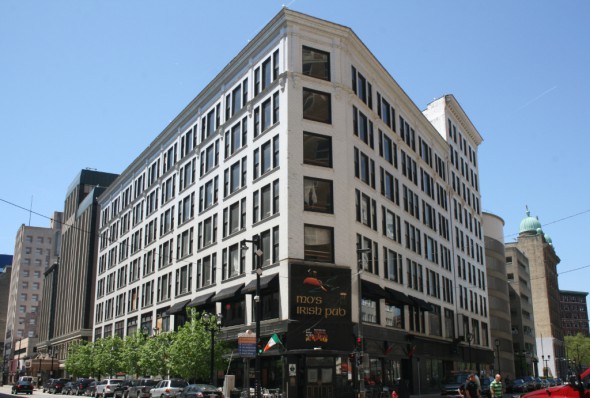City Residents Hiring Program Falls Short
Promising effort employs minorities in construction, needs more monitoring and funding.
In January 2013, Fabian Hinkle had just been caught with five grams of crack cocaine. The charge, possession with intent to sell, would have put Hinkle, who had already served a total of 15 months for two earlier marijuana-related cases, behind bars for 11 years.
While he was awaiting sentencing in the Milwaukee Secure Detention Facility, Hinkle learned his ex-girlfriend was pregnant.
“Honestly, I prayed,” he said. “I was like, ‘God, if you let me out of this, I’ll quit selling drugs.’” The case was eventually thrown out because the evidence against Hinkle was obtained in an illegal search.
Now a third-year plumbing apprentice, Hinkle is building a future for himself, at least partially thanks to the Residents Preference Program, a City of Milwaukee program that helps unemployed and underemployed city residents get work on large development projects. Hinkle worked on the new Northwestern Mutual Tower and Commons development downtown early this year.
“I went from nothing to making good money,” said Hinkle, who said the starting wage for a plumbing apprentice is about $16 an hour. “When I top out, I’ll be making close to $100,000 a year.”
He added, “I get my daughter every weekend, pay my child support and she’s on my insurance. There’s nothing more I can ask for. I’ve got a good job with a 401k, a pension, healthcare.”
The Residents Preference Program (RPP) has provided opportunity for struggling city residents but, according to multiple interviews with workers, aldermen and other city officials, the program must be better funded and more closely monitored to achieve the greatest impact.
Mark Kessenich, president of WRTP/Big Step, a nonprofit workforce organization whose mission is to connect people to family-sustaining jobs, said the RPP could be a tool to address some of the most pressing issues Milwaukee is facing.
RPP was created by former alderman and mayor Marvin Pratt in 1991 as a Department of Public Works (DPW) program. In 2009, as a result of legislation commonly referred to as the Milwaukee Opportunities Restoring Employment (M.O.R.E.) Ordinance, it was expanded to include privately owned projects overseen by the Department of City Development that receive city funding.
Chapter 355 of the city’s ordinances states that 40 percent of the workers on development projects that receive more than $1 million in direct financial assistance from the city must be unemployed or underemployed residents. That includes people who have not worked in the last month, have worked less than 1,200 hours during the last year or whose income is below the federal poverty line.
But the program is not enough, said Milwaukee NAACP President Fred Royal. He said it needs to provide improved long-term economic outcomes for the city’s most vulnerable residents.
Kessenich agreed. “Anything short of that, I feel like … we’re [short]-changing the people that we are dedicated to serve.”
Crime, incarceration and unemployment
The ordinance required 15 percent of the workers on DPW projects to come from areas eligible for federal Community Development Block Grants (CDGB), which include many of Milwaukee’s lowest-income neighborhoods. Eventually, that requirement was raised to 25 percent, before increasing to 40 percent in 2009.
Pratt, who lived in the 53206 ZIP code at the time, said his goal was “to employ those people who were chronically unemployed or underemployed.” Although the majority of those individuals were African-American, he said the RPP couldn’t be race-specific because block grant funds are not distributed in a race-specific way.
Pratt did not find many in government, or outside of it, who were supportive. “The unions were pretty entrenched relative to protecting their members,” he said, adding that both the members of most unions and the contractors were predominantly white.
In Wisconsin, black unemployment is nearly 20 percent, the highest in the nation, according to a 2015 study by the Economic Policy Institute. Research by Marc Levine, director of the Center for Economic Development at the University of Wisconsin-Milwaukee (UWM), shows employment rates for black males in Milwaukee have plummeted since 1970.
Between 1970 and 2007, a year before the worldwide economic downturn, the percentage of black males in their prime working years (25-54) with a job declined 28 points, from 84.8 to 56.8 percent. The percentage for employed white males dropped less than five points over the same period, to 85.1 percent. According to Levine, as of 2010, less than 45 percent of Milwaukee’s entire population of working-age black men was employed.
In Milwaukee County, more than half of African-American men in their 30s have served time in state prison; one in eight black men in Milwaukee County is currently incarcerated. A 2013 study by John Pawasarat and Lois M. Quinn of UWM’s Employment and Training Institute said governmental policies and practices in Wisconsin have led to this mass incarceration, including increased funding for drug enforcement and prison construction, mandatory minimum sentences and disproportionate policing of minority communities.
The study shows more than 26,000 black men from Milwaukee County were incarcerated between 1990 and 2011. Forty percent were drug offenders and a third had only non-violent offenses. According to the report, “prison time is the most serious barrier to employment.”
Ald. Russell Stamper, who recently oversaw an effort to enhance RPP, noted, “The number one way to fight crime is through employment.”
Opportunity
Fabian Hinkle describes himself as “the typical stereotype of a young black man,” before the incident that set him straight. He said he “can’t really make excuses for it” but that his situation was the result of not being exposed to opportunities that other people might have access to.
“You’re a product of your environment,” said Roy B. Evans, an attorney who was a member of Milwaukee County’s first Minority Business Enterprise Committee, established in 1983. “You don’t necessarily want to deal drugs — you want to have a job to support yourself and your family. You don’t want to face the prospect of 20 years in prison, you don’t want to face the prospect of getting killed, but that’s the environment that you’re in.”
Adam Dokes, a second-year plumbing apprentice who is certified under RPP, said he made some bad decisions as a teenager. When he was 18, Dokes was convicted on a drug charge and served five years behind bars. While incarcerated, he took some college classes and construction-related courses. When he was released, Dokes got involved in a training program at WRTP/Big Step.
“Sometimes, you grow up … around certain things. And, when you grow up around it, as a kid, you tend to think that it’s not as wrong as it really is — it’s somewhat like a ‘normal’ to you,” said Dokes. “It’s not until … somebody invests in you enough to tell you that there’s another way (that things change).”
Luckily for Dokes, he had someone in his life, a pastor and family friend, who believed and invested in him. “For me, it’s kind of fulfilling to be able to use these same hands that I used to destroy the same community I live in … to also build and give back.”
Hinkle was asked to leave his first plumbing apprenticeship because he was not performing adequately. He found it difficult to have “somebody else tell me what to do, how to do it, and how fast I should be doing it,” he said. Hinkle said he was used to making his own money and doing things when and how he wanted.
“You’ve got to get out of that mindset, and you’ve got to open your mind. You can’t just be stuck in your old ways,” he said. “I’m not selling drugs no more — this is a whole different environment.” Hinkle started an apprenticeship for the second time in 2013.
In addition to the challenges many young men of color face in Milwaukee, finding employment in the construction industry can be hard for non-white workers because the jobs, and acceptance into unions, often depend on relationships.
“No one really wants to hire you offhand unless you know somebody,” said Lewis Gregory, 46, who was certified under RPP in February 2011. At that time, Gregory had just been admitted to the Milwaukee Laborers’ Union 113 and found work shortly after in the construction industry as a dump truck driver with a company in Waukesha, starting at $32 an hour. Gregory said he wanted to get back into construction because his wife had gotten tired of him being on the road.
But that job didn’t last long. In early November 2011, he was laid off and told there would be no more work until March; Gregory said he couldn’t wait that long.
A commercial truck driver since 1991 who holds multiple license certifications, Gregory went back to long-haul trucking where he was earning $2,500 every two weeks in a salaried position.
A couple years later, Gregory tried to get back into the industry once again, but wasn’t able to find work.
“There’s a lot of minorities that [are] certified and in a union, and we always get passed [over for] work,” said Gregory, who is black. “Construction is a field [where] you still have a lot of prejudice going on, and everybody knows about it. So, that’s the problem. Minorities don’t get the opportunity — the only way we get in is we’ve got to know somebody working there.”
He added, “I don’t know anybody in construction. So, that was that, you know?”
For others, such as Dokes, there are challenges even once they get into the industry. Before becoming a plumbing apprentice, Dokes worked as a non-indentured electrician at Roman Electric for seven years, a job he got through WRTP/Big Step. In 2011, DPW determined that Dokes had been underpaid for 546 hours of work on a development project.
In an email to Dokes in March 2011, a DPW employee wrote: “Per phone conversation with Jan of Roman Electric at 1:30 this date, she tells me that Roman is ready to cut a check for $14,933.64 once you return their tools to them.”
Dokes was let go that day. He said it is not uncommon for a worker in that situation to be laid off. Dokes has no doubt that the firing was retaliatory, but when the company says it’s because there isn’t enough work, it’s hard to dispute. On top of that, he said making trouble for contractors can cause trouble.
“A lot of the contractors are both employers and a lot of them are also on committees — union committees, they’re on the boards of apprenticeship committees — so, you kind of tick people off and it can get pretty volatile real quick.”
Spokesperson Sandy Rusch Walton said DPW will withhold payments to a contractor when it gets a notice of underpayment of wages, but does not get involved past that. “We do not get involved in the circumstances of why an employee may have been let go. There could be a variety of reasons that may or may not be related to the payment of wages,” she said.
She added that DPW is no longer involved in Dokes’ situation. Phil Rose, president of Roman Electric, did not respond to requests for comment.
Hinkle said many contractors will contract with small, minority businesses to cover the hours needed to fill the requirement on projects and, once that’s done, the individuals are out of a job.
“It’s happened to me quite a few times working for different companies,” Hinkle said. “When they need you they need you; when they don’t, they don’t.”
Royal said the focus should not be on fulfilling an hours requirement for developers and contractors, but rather on creating long-term opportunity for individuals. “We have to make this a sustainable career ladder.”
Hinkle said, despite the drawbacks, there are a lot of positives. He estimates about 30 to 40 percent of the jobs he’s worked as an apprentice were because of RPP; it’s honest work that’s allowed him to feed his family legally. He said more people should get involved in the skilled trades. There are almost 20 skilled trades and “trades within trades,” according to Kessenich.

Milwaukee NAACP President Fred Royal has been vocal about the need to improve the RPP. Photo by Jabril Faraj.
The work isn’t easy, but it’s rewarding. Hinkle, who’s making almost $25 an hour as a third-year apprentice, is looking forward to the raise he’ll get when he graduates to fourth-year status, and beyond that to journeyman wages of just under $40 per hour. He and Dokes each said his goal is to become a master plumber and open his own business.
“This is a knowledge that no one can take from me,” Hinkle said. “I’ll never be broke again a day in my life.”
Adolfo Perez, who has been a mechanical insulator since 2006 and is RPP certified, estimated 40 percent of the work he’s done has been through the program. He said that before construction, he worked a series of low-wage jobs.
“I was doing anything and working anywhere where they would hire me, pretty much,” said Perez. “I never stayed long enough at a company, because I didn’t like what I was doing at the time.”
Now, he’s making $32 an hour as a journeyman. He said it’s a lot of responsibility but he has acquired the skills to know what he’s doing and the variety keeps it interesting. “We go from job site to job site and every job is different. I never know what I’m going to do next week.”
Evans, who’s been involved in workforce development since the ‘80s, lives near 43rd Street and North Avenue. He said it’s difficult to walk down the street in his neighborhood and see the hopelessness there. It doesn’t make sense, particularly when hope is abundant elsewhere, he added.
“I go out in Wauwatosa and, then, I see hope, I feel hope — you know? — I experience hope,” said Evans. “That should be the same all over.”
Working for residents
The Residents Preference Program is about trying to “address longstanding disconnections in the labor market” to benefit people who have not traditionally been aware of opportunities that exist, said Kessenich, president of WRTP/Big Step. He added that perhaps those people have wanted to get involved in the trades but didn’t have the necessary skills.
“We want folks to not just be certified, we want them to be qualified and work-ready,” said Kessenich.
Royal agreed. “We can’t just have an RPP certification — a piece of paper that says ‘I’ve been unemployed … I make less than $34,000 and I live in the City of Milwaukee. Currently, that’s what an RPP certification says.”
At the beginning of this year, the city’s Workforce Organizational Reform Committee, led by Stamper, held a series of meetings with developers, contractors, unions and community members as part of a process to update Chapter 355 and Chapter 370, which governs the Small Business Enterprise program.
The resulting ordinance, passed in June, removed a limit that only allowed workers to be RPP-certified for five years. It requires one-quarter of RPP workers on a given project to be from one of the five most impoverished ZIP codes in Milwaukee; created further incentives for employing and training RPP workers; included tougher sanctions for contractors or developers that fail to meet requirements; and created a commission to review compliance, performance and other aspects of the program.
“This piece of legislation’s going to be big for the way we do business with contractors and with developers moving forward in Milwaukee,” said Stamper.
Current RPP projects include the Northwestern Mutual Commons and the Posner Building development, 152 W. Wisconsin Ave., which have a combined cost of more than $333 million. Future projects that will eclipse the $1 million threshold include the new Bucks arena, The Couture and the downtown streetcar. Stamper stressed that Milwaukee’s struggling populations need to be included in — and benefit from — this development boom, which he estimated to be worth billions of dollars.
In a November 2015 interview, Common Council President Ashanti Hamilton said he would like to see the RPP requirement apply not only to these massive projects, but to every development in the city. “I think the attention that the program is getting now is raising the profile of the program and is raising the community expectation of what can be done,” Hamilton said.
He added, “It needs to be a priority for the administration.”
Diverse, qualified individuals are available, Kessenich said. WRTP/Big Step has certified 4,848 people since 2009, when the M.O.R.E. Ordinance was enacted; the organization has certified more than 75 percent of RPP workers between 2011 and 2015. Kessenich said Big Step doesn’t receive any funding for the certifications it performs, which he estimated take about 30 minutes each.
As of January, the total pool of RPP-certified individuals was 8,757, according to a Public Policy Forum report released early this year. A total of 1,426 RPP-certified individuals were active on at least one city of Milwaukee public works project between 2010 and 2015.
The number of hours RPP-certified individuals work on development projects has been increasing. In 2014, 411 RPP-certified individuals worked 124,880 hours on city-supported private development projects, according to numbers from the city’s Office of Small Business Development (OSBD). In 2015, 548 RPP workers logged more than 250,000 hours on such projects. That increase was due to the Northwestern Mutual development, on which 48 percent of the hours worked were by RPP workers, according to the 2015 annual RPP participation report.
Chapter 355 requires a city agency or its designee to refer qualified RPP-certified workers — before the positions are advertised elsewhere — to development projects that receive direct financial assistance from the city.
According to Hamilton, a Memorandum of Understanding in 2009 designated Employ Milwaukee, formerly the Milwaukee Workforce Investment Board, as the agency responsible for these referrals.
However, Earl Buford, president and CEO of Employ Milwaukee since June 2014, said that during his tenure the organization has not performed the duties stated in the ordinance.
Buford said he was never told the duties that were expected, nor how to achieve them. “The city council can’t mandate that we serve in that role,” Buford said. “What they can do is approach us and develop the process for how to do that. That has not happened.”
Employ Milwaukee receives between $8 million and $10 million per year of federal Workforce Investment Act dollars to fund training programs and coordinate employment opportunities between contractors and workers. According to Buford, Employ Milwaukee funds “pretty much every training program in town around construction,” including some with Big Step.
The apparent confusion over who is responsible for referring RPP workers for jobs contributes to the program’s failure to fulfill its promise. “I think that’s part of the challenge that we’ve had with meeting some of the goals of the program,” Hamilton said.
But sources also said lack of training for RPP-certified individuals is a major problem. Only 14 of the 411 RPP workers who were employed on development projects in 2014 were apprentices or on-the-job trainees.
Rashawn Spivey, a master plumber and owner of Hero Plumbing, said RPP workers are typically good for “general labor help” but do not have enough training to work in a highly skilled trade such as plumbing.
Spivey noted that when high-priced journeymen must be used to train a new worker it’s difficult to be competitive. A typical plumbing apprenticeship includes 8,000 hours of work, he said. In the old trade-school model, a high school graduate would already have 3,000 hours in a particular trade. Spivey stressed the need for pre-apprenticeship training.
Buford said he thinks there should be training attached to an RPP certification, but that is up to city policy-makers to decide. “That’s not our decision to make,” he said.
Originally, Chapter 355 required contractors and subcontractors to employ apprentices and on-the-job trainees. However, Stamper said there was no process set up to connect RPP-certified individuals with training opportunities.
“There were no apprenticeships,” he said. “None.”
The updated ordinance spells out requirements for the percentage of apprentices and on-the-job trainees on any development contract greater than $100,000 and states that one-quarter of apprentices and on-the-job trainees for contracts greater than $500,000 must be RPP-certified.
According to Kessenich, WRTP/Big Step is “half of the organization that [it] ought to be” to fully serve the local construction industry and provide people with the economic opportunity they need. He said much more could be done if there were “a more robust and aggressive approach to investing in the workforce.”
Referring to city lawmakers, Kessenich said, “If you want to implement ordinances, you’ve got to figure out who you’re putting the cost on.” He added that a lot of municipalities pass ordinances but they don’t fund efforts to help contractors meet the requirements.
No line items in the 2016 city budget are dedicated to RPP. Department of Administration Director Sharon Robinson said some city positions include responsibilities related to RPP, but was unable to provide a list of those positions.
According to Royal, four people employed by the City of Milwaukee are responsible for monitoring and enforcing RPP, the city’s Emerging Business Enterprise and Small Business Enterprise programs. He said the average city the size of Milwaukee has 11 people responsible for contract compliance and monitoring.
Joe Peterangelo, a senior researcher at the Public Policy Forum, said hiring goals and requirements will only do so much. He said effective programs similar to RPP in other cities are constantly monitoring whether more workers need to be trained to meet demand. He said, so far, that has not happened here.
“There needs to be long-term communication happening between these different stakeholders … to make [sure] the program actually [does] what it’s supposed to do,” said Peterangelo.
Employ Milwaukee needs to do better to implement Chapter 355, Stamper said, adding, “I think we all need to do better. I need to do better,” he said. “We have to do better because our city needs it.”
Stamper suggested creating an outreach program to certify residents and give them information about opportunities in the construction industry. A position for a Workforce Development Coordinator within the City Clerk’s office, which would be responsible for outreach and monitoring, is currently being advertised.
Evans is hopeful that the additional enforcement tools included in the updated ordinance will improve the program’s effectiveness, but he’s still skeptical whether the program will be allowed to work the way it’s supposed to.
“Racism is the alpha and omega of what is wrong in this city,” Evans said. “There will be challenges — and there should be — but my question is: are we ready to meet the challenge and finally say enough is enough?”
According to Royal, it’s not going to be easy. He said the city must be strategic about implementing the program, with an eye toward the future. “We’re changing the dynamics of an industry. We’re changing how an industry does business,” Royal said. “Once you’re comfortable doing something, it’s hard to break that routine.
“This is not going to happen overnight,” he said. “This is a five, 10-year plan.”
But in the meantime, RPP has changed the life of at least some participants.
“I was once told that the more tools you have in your chest, the better off you are,” said Dokes. “If I have the tools then there’s nothing I can’t do.”
That attitude, Dokes said, is a direct result of the belief his family, Big Step and others have had in him. “There’s so many people I don’t want to let down, there’s so many people I want to make proud … because they made sacrifices along the way so that I could do what I’m doing now.”
This story was originally published by Milwaukee Neighborhood News Service, where you can find other stories reporting on fifteen city neighborhoods in Milwaukee.
Political Contributions Tracker
Displaying political contributions between people mentioned in this story. Learn more.
- October 10, 2017 - Ashanti Hamilton received $100 from Marvin Pratt
- February 8, 2016 - Ashanti Hamilton received $200 from Marvin Pratt



























What is the funding used for in programs like this? Monitoring? This should be no/low cost program if it only consist of making sure that vendors are following the guide lines.
Man…I was really hoping this article was going to get more comments. I guess people much rather complain/debate about architecture or budget projections.
Programs like this whether you agree with them or not have a real and direct effect on people’s lives.
Good article and well humanized.